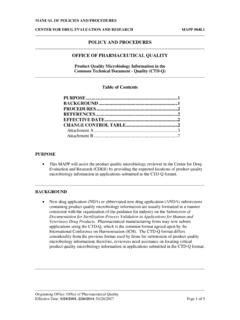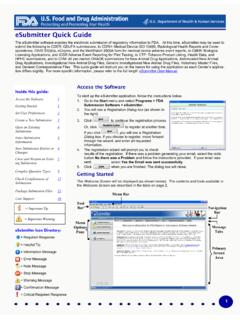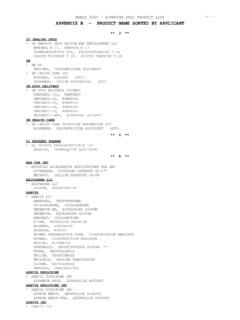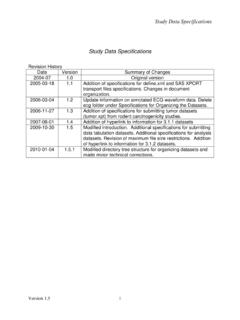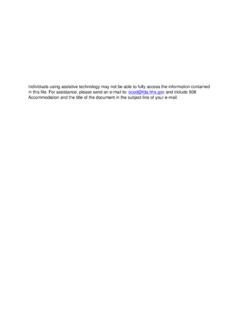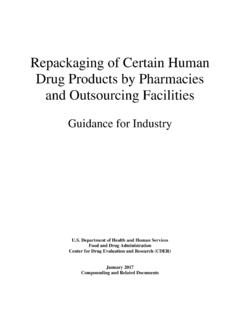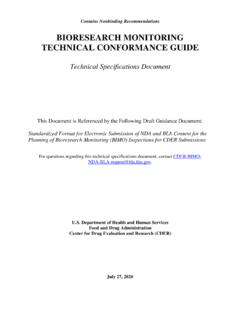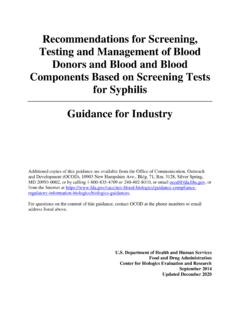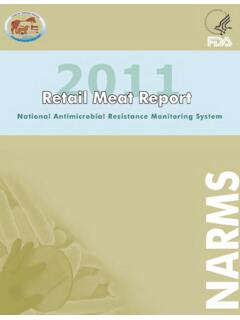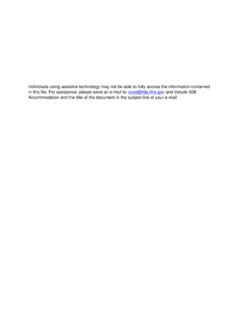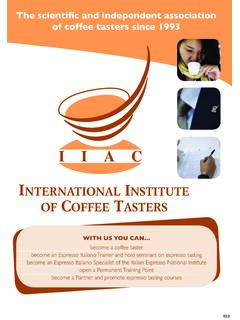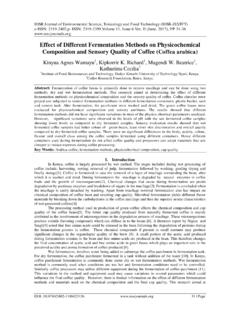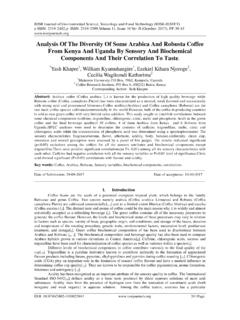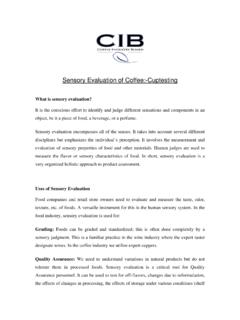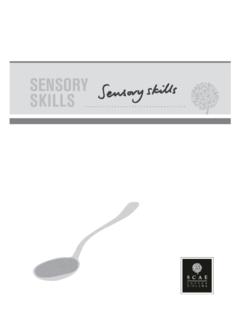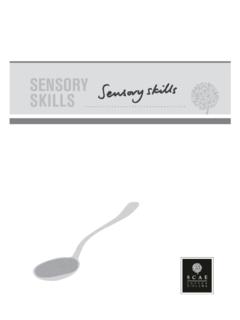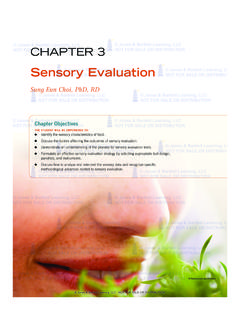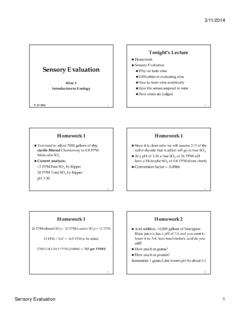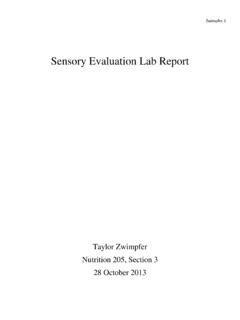Transcription of DOCUMENT NO.: IV-08 ORA LABORATORY
1 FOOD AND DRUG ADMINISTRATION OFFICE OF REGULATORY AFFAIRS ORA LABORATORY Manual Volume IV Section 8 DOCUMENT Number: IV-08 Revision #: 02 Revision Date: 05/27/2020 Title: sensory Analysis Page 1 of 18 Sections in This DOCUMENT 1. Purpose ..2 2. Scope ..2 3. Basic Considerations for Selecting Objective sensory 4. 5. References ..3 6. Procedure ..3 Taste Exercise ..3 Equipment Needed ..3 Exercise Set Up ..4 Screening Exercise.
2 4 Analysis of Authentic Sample Blind Discussion Practice Test ..6 Final Test 7. sensory Category 1: Fresh /Frozen Raw Category 2: Fresh/Frozen Raw Finfish (other than scombrotoxin-forming fish species)..6 Category 3: Fresh/Frozen Raw Scombrotoxin-Forming Fish Category 4: Processed Scombrotoxin-Forming Seafood Products Other Than Canned/Pouched (Retort) Category 5: Processed Seafood Products (other than scombrotoxin-forming fish species)..7 Category 6: Canned/Pouched (Retort) Tuna..7 sensory Odor Definitions ..7 8. Records ..13 9. Supporting Documents.
3 13 10. DOCUMENT History ..14 11. Change 12. For the most current and official copy, check QMiS. FOOD AND DRUG ADMINISTRATION OFFICE OF REGULATORY AFFAIRS ORA LABORATORY Manual Volume IV Section 8 DOCUMENT Number: IV-08 Revision #: 02 Revision Date: 05/27/2020 Title: sensory Analysis Page 2 of 18 Attachment A - sensory Attachment B - sensory Analysis Questions ..17 Attachment C - Answer 1. Purpose This DOCUMENT provides guidelines/ instructions/ policy for sensory analysis of seafood and requirements for sensory analysts.
4 2. Scope sensory analysis is a critical tool used by FDA to protect consumers from seafood that has become adulterated due to decomposition. To stand up in court, the integrity of the sensory program depends on the credibility of the sensory analysts and the manner in which the analyses are conducted, reported, and interpreted for regulatory purposes. 3. Responsibility Basic Considerations for Selecting Objective sensory Analysts Personality Factors: Personnel who perform sensory tests should be motivated for the job, responsible, dependable, conscientious, and use tact, per ISO 13300-1 sensory analysis General guidance for the staff of a sensory evaluation LABORATORY .
5 Staff Responsibilities: The following is from ISO 13300-2 sensory analysis General guidance for the staff of a sensory evaluation LABORATORY A. sensory Analysts sensory analysts should demonstrate that they have the ability to perceive basic odors and tastes and be able to describe their findings in a consistent manner. One area that is important in selection and training is the ability of the analyst to distinguish between the four basic tastes which are bitter, sour, salt, and sweet. B. Panel Leaders and Trainers: A panel leader needs basic knowledge in sensory evaluation principles to facilitate his/her job as panel should be confident, friendly, capable of maintaining authority and control of the group, and command respect.
6 The panel leader should be able to inspire the assessors, keep them motivated, and tactfully solve problems within the For the most current and official copy, check QMiS. FOOD AND DRUG ADMINISTRATION OFFICE OF REGULATORY AFFAIRS ORA LABORATORY Manual Volume IV Section 8 DOCUMENT Number: IV-08 Revision #: 02 Revision Date: 05/27/2020 Title: sensory Analysis Page 3 of 18 panel. For the panel to be effective, the panel leader needs to be patient, fair, honest, and non-judgmental. 4. Background It takes many years of experience, with daily involvement, to properly recognize spoilage odors and flavors in seafood products and, more importantly, to avoid rejecting products due to odors and flavors that may be present but are not caused by decomposition.
7 Incorrect decisions by FDA can be extremely costly to the importer/owner of rejected product and failing to detect adulterated product is costly to consumers. 5. References Section 402 (a)(3) of the Food, Drug, and Cosmetic Act states that a food is deemed to be adulterated if it consists in whole or in part of any filthy, putrid, or decomposed substance, or if it is otherwise unfit for food. It is this section of the Act that lends itself to the findings of the sensory analyst. 6. Procedure Taste Exercise Purpose: To demonstrate basic taste sensations to candidates for later testing purposes. Equipment Needed One-gallon spring/filtered water.
8 Four 500 mL graduated glass or Nalgene flasks with covers. Four 2-ounce plastic cups with lids for each participant. Cups for rinsing and spitting. Gram scale. Compounds [sucrose (sugar), citric acid, NaCl (salt), and caffeine]. Ballots (see Attachment A: sensory Scale). For the most current and official copy, check QMiS. FOOD AND DRUG ADMINISTRATION OFFICE OF REGULATORY AFFAIRS ORA LABORATORY Manual Volume IV Section 8 DOCUMENT Number: IV-08 Revision #: 02 Revision Date: 05/27/2020 Title: sensory Analysis Page 4 of 18 Exercise Set Up Prepare the four basic taste solutions one or two days prior to screening.
9 Add compound to flask, then fill to 400 mL with filtered water. 1. Sweet: g sucrose. 2. Sour: g citric acid. 3. Salty: g NaCl. 4. Bitter: g caffeine. Store bulk solution in cooler/refrigerator. Label the side of the cups with the number associated with solution, 1 each per participant: 1= sucrose, 2 = citric acid, 3 = NaCl, and 4 = caffeine. Let compound sit overnight and shake to dissolve. Fill the 2 oz. cups half full and cover. The analyst should have enough solution to make up 15 to 20 cups. Make sure solutions are at room temperature when presented. Screening Exercise Remove cups from cooler one to two hours prior to screening.
10 It is important that the solutions be evaluated at room temperature. Present the four basic tastes. Pass out ballots and read instructions to participants. Have them go through the samples in order and ask them to pay attention to where they are sensing the solutions on their tongue and how long it takes to detect. Ask them to save some for re-tasting. Analysis of Authentic Sample Packs FDA seafood sensory analysts are evaluated for their ability to make correct regulatory decisions in the following six categories of seafood products: Category 1: Fresh/Frozen Raw Invertebrates Category 2: Fresh/Frozen Raw Finfish (other than scombrotoxin-forming fish species) Category 3: Fresh/Frozen Raw Scombrotoxin-Forming Fish Species For the most current and official copy, check QMiS.
